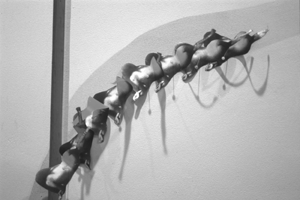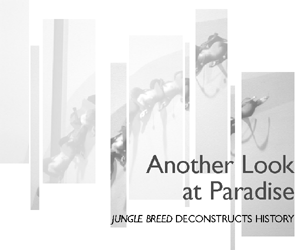

When many Americans think of the jungle or of Pacific Island culture, associations are often made to brightly colored flowers, idyllic beaches with palm trees, sensual natives, and cocktails served with pink umbrellas. The recently closed exhibition Jungle Breed, shown in SAIC’s Lounge Gallery, featured work by Leua Fekusone Latai, Michelle Corpus, and Tomiko Pilson. Jungle Breed addressed these clichés through work that reconstructs history, forges personal identity, and mirrors back to the viewer their own misconceptions of Pacific Island culture.
Art history is referenced frequently in the work. In her self-portrait diptych “Me and those Dreamy Eyes of Mine,” Tomiko Pilson illustrates herself as a “native” woman with an animal-like sexuality à la Gauguin. Pilson commented on her view of the Fauvist known for his depictions of young girls: “In a lot of ways, Gauguin’s paintings were painted from an outsider’s point of view where women were objectified and just sort of there; whereas this painting is of me and created by me.”
In one panel she holds the severed head of a white man, referencing the many European paintings that feature David holding the head of Goliath, Judith with that of Holo-fernes, and Salome being presented the head of John the Baptist. Pilson has even named this fictionalized version of herself, whom she calls the “Vamp of Zambowanga.” The “vamp” aspect is straight out of a B-movie, and is illustrated by the animal print dress that fails to cover one of her breasts, and Zambowanga is a southern part of the Philippines, which Pilson described as “a politically tense place ... [where] recently some missionaries were beheaded.”
In her self-portrait, “The Most Beautifullest Thing in this World,” Pilson borrows much imagery from pop culture. Pilson commented that the painting “references B-movies from the ’80s, theme parks, Trader Vic’s kind of restaurants, Tiki lounges — everything that Westerners think is tropical and exotic.” The palette itself is loud and garish; the colors include Rainforest Cafe green and day-glo orange, and the large size of the painting likens it to a restaurant mural or movie billboard.
Leua Fekusone Latai also pulls from pop culture. “Bunny II” is a
pink Playboy Bunny that is comprised of a repeated photo of a nude woman that
appears to be taken out of an anthropology book. It is the first thing the viewer
notices when walking into the gallery and packs quite a punch. Quite literally,
Latai’s work seems to respond to anthropological history and the objectification
of non-Westernized women. She said, “My work is really about the deconstruction
of history and I reconstruct it back to the way I see things.”
The same “native” woman from “Bunny II” appears in the site-specific piece “Manulele o le Vaomaoa.” Here the woman is shaped into a flower that ignores the edges of the orange panels that attempt to hold the organic form in. Latai’s work is more subtle and streamlined than Pilson’s and Corpus’ and suggests quiet discontent but is made accessible through a sense of humor. Latai commented that her goal is to communicate what she has to say “without having to doink anyone over the head.”
She added, “I felt I succeeded without having to be too explicit or literally having to explain itself. The [work] should visually do all the talking.”
Michelle M. Corpus exhibited work that was quite varied in style from one piece to the next. The most effective of her three pieces was the installation “A Child of the Obrero.” The piece is a series of the same photographic print of the artist, taken when she first came to America at age two, that was altered in Photo-shop.
The prints are installed to appear as if they are hanging from clothes pins on a clothes line that has been severed between the images. Under-neath the prints is the text: “A child of the Obrero knows her entire family — titas, titos, loas, ates, pinsans, kuyos for they all live in the same split-level shanty, walk on the same concrete floor and eat from the same pot of rice every night.” Corpus said that “child of the obrero” translates to “child of poverty.”
Commenting on the use of clothes pins and clothes line, Corpus
said that they can be found in any ghetto. She said that they function as a
metaphor for her disconnected, floating thoughts and memories regarding the
Philippines and also represent a severed umbilical cord, which can be inferred
as that from her home country. 
The prints are also accompanied by text; each print is provided with an individual title. In one photograph, the figure is given camouflage and the text “just another minority bitching about the system.” Corpus said that it comments on being described as “militant just because I’m asserting myself.” The print titled “re location” illustrates Corpus’ liquid, ever-changing attitude towards being Philipino-American and, as she said, “not belonging to either culture.”
Corpus also discussed how the series was received in a class critique. She said that “a lot of people were just shocked into silence because they didn’t know this was going on in my head. They just saw me as another student — [they think they] see you in class all the time, [that] she doesn’t look like she has any trouble.”
Commenting on her politically charged paintings, Pilson said that sometimes “people don’t know what to make of the work. Some people ... [say] ‘wow, pretty’ and think it’s attractive but don’t always look critically at it. ... I wish I wouldn’t have to explain my work in critiques as much as I do ... and [that viewers] would just quickly see the references, but that would mean history would have to be taught differently.”
Corpus believes that many people have the attitude of “just because I can’t relate to it, then I’ll just pass it.” She mentioned that her boyfriend videotaped the show’s opening and that the footage captured many people doing just that. But, Corpus added, to understand a new vocabulary, “you have to [see] it over and over again.”
All three of the artists felt the show was a success. Latai said, “there should be more collaborative work from students from other countries” despite background differences. She was also impressed by the audience the show received. She said, “I’ve
Image: "Manulele o le Vaomaoa," by Leua Fekulsone Latai.
Courtesy of Leua Fekelsone Latai and Michelle Corpus